In this article we will discuss about:- 1. Geographical Distribution 2. Habits and Habitat 3. Affinities and Systematic Position of Herdmania.
Subphylum Urochordata (Gr., uros = tail; chorde = cord) includes a peculiar group of widely distributed marine animals called sea squirts or ascidians and their allies. In most of them several chordate characters are lost in the adults, but their chordate affinities are clearly seen in their free-swimming larvae which have pharyngeal gill-clefts, a dorsal tubular central nervous system, and a notochord which is confined only to the tail (hence, the name Urochordata).
During metamorphosis the chordate characters are lost except gill-clefts. Gill-clefts do not open to the exterior but into an ectoderm-lined atrium. The body becomes surrounded by a coat called test or tunic (hence, the name Tunicata). The changes in metamorphosis are a specialisation due to a sedentary life in which ciliary feeding is perfected, due to which locomotory organs and neuro-sensory system are simplified and reduced.
They have no metameric segmentation and a coelom is absent. They are also hermaphrodite. About 2,200 Urochordata are known, they show a great diversity of structure, habits and habitats. They may be sessile or free-swimming. They are found in all seas, being found along the shores and up to a depth of more than 3 kms.
ADVERTISEMENTS:
The genus Rhabdocynthia was first established by Herdman in 1891. But, in 1910, Hartmeyer changed it to Herdmania according to the law of priority as it was originally proposed by Lahille in 1888.
1. Geographical Distribution:
The Urochordata or Tunicata (L., tunica = outer covering) are marine animals found in all seas and at all depths, extending from the arctic and the antarctic regions to the tropics and from the littoral zone down to the abyssal depths of over 5 km. The Urochordata are derived from a common sessile ancestor and the most generalised condition of the class is found in sea-squirts to which Herdmania belongs.
Herdmania is the commonest monascidian found in the Indian seas. Of the twelve known species of Herdmania, however, only four have been recorded from the Indian Ocean, i.e., H. pallida, H. ceylonica, H. mauritiana and H. ennurensis. Out of these again only the first two have been recorded from the coastal waters, while the remaining two are usually found in deeper waters.
Systematic Position:
2. Habits and Habitat:
Herdmania pallida is a solitary marine form found in shallow waters along the Indian sea coast. Each animal is found attached to the substratum usually separately, at its postero-ventral end by means of a foot. When the substratum is sandy, an expanded or elongated foot is formed which remains imbedded in the sand and keeps the animal fixed to the sea bottom. A large number of organisms inhabit the test of Herdmania, some of these are merely attached to its surface, while others are more or less imbedded within its substance.
Sometime an individual is found attached to a living gastropod shell (e.g., Turbinella pyrum, T. rapa, Xancus, etc.) showing commensalism. Herdmania protects the gastropod from enemies since it is unpalatable due to its spicules, and gastropod takes it from place to place so that it may get good food and oxygen, etc. The food of Herdmania consists of microscopic plants and animals, e.g., diatoms, algae and infusorians.
Herdmania is more or less widely distributed, though it cannot be called a cosmopolitan species. H. pallida having been recorded from the Indian, the Pacific and the Atlantic Oceans, as also from Malaya and the West Indies. Herdmania is hermaphrodite and oviparous. Fertilisation takes place in the sea and the tadpole larvae emerging from the eggs lead a short free-swimming life before they settle down to the sea-bottom to lead a fixed existence after going retrogressive metamorphosis.
3. Affinities and Systematic Position of Herdmania:
The systematic position of Urochordata had been remained controversial. Lamarck (1816) first called them Tunicata. Cuvier (1817) classified them along with Mollusca but Lamarck placed them between Radiata and Vermes. Milne Edwards (1843) established the class Molluscoidea in which he included Bryozoa and Tunicata, to which Huxley (1853) also added Brachiopoda.
ADVERTISEMENTS:
However, Kowalevsky (1886) put an end to the controversy when he described the development of a simple ascidian and established their chordate nature. Since then the urochordates have been placed as a class or suphylum under the phylum chordata with certainty.
The adult ascidian derived through retrogressive metamorphosis of tadpole larva has lost most of its chordate characters, yet it shows its chordate affinities in the following points:
1. The branchial tentacles resemble the velar tentacles of Amphioxus.
2. The pharynx of tunicates is like that of Cephalochordata with numerous stigmata, glandular ciliated endostyle, peripharyngeal bands and a dorsal lamina (or epipharyngeal groove).
3. Endostyle is homologous with thyroid gland of vertebrates.
4. Ciliary filter feeding mechanism and respiratory system in urochordates and cephalochordates are similar.
5. Origin and position of neural gland suggest its homology with the pituitary gland of vertebrates. Even more than the adult, the tadpole larva shows its chordate characteristics in its nervous system, stigmata and notochord.
Besides these it has:
(a) A muscular postanal tail with tail-fin,
ADVERTISEMENTS:
(b) Cleavage and gastrulation in ascidian development are similar to those of chordates.
The urochordate tadpole larva is the relic of free-swimming chordate ancestor. Its degeneration is a secondary modification due to sedentary mode of life of adult.
Thus, Urochordata have been derived from a free-swimming chordate ancester and their closest affinities are with the Cephalochordata. The two classes have such close homologies that they show a common ancestry.
